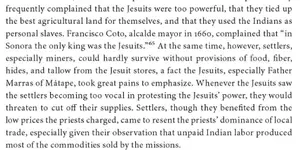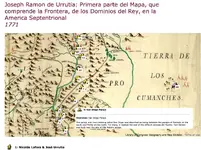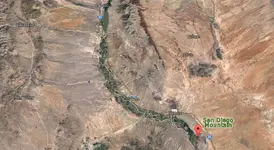Ryano
Hero Member
- Joined
- Feb 16, 2014
- Messages
- 759
- Reaction score
- 1,282
- Golden Thread
- 0
- Location
- St. Augustine, FL
- Primary Interest:
- Cache Hunting
Thanks for replies, Mike and Somehiker.
Last edited:
I've been meaning to go through my notes for the sources, dates and other circumstances for this, but wasn't it Roxas who went awol for a time ?
Also, one of the Fathers whose journals we do have, had noted when he first arrived at Casa Grande (post Kino), that excavations had been made within one of the other compounds...."B" perhaps, by the description. Was it dug by Kino or one of the other Jesuits, and did they find something worth hiding elsewhere ? A GPR done by Richard Robinson and his group also showed a large anomaly outside the doorway to the Main Building of compound "A", but the NPS refused them permission to dig......no surprise there.
So, you're saying that the Jesuits began caching valuables in Arizona two years prior to the expulsion?
I am saying that I think it was more likely than not that Jesuits worldwide in Spanish Lands were not completely surprised in 1767.
The Jesuits were/are not stupid people. They were suppressed in Asia, in 1759 in all of Portugal's Lands Worldwide, in 1764 in all of France's Lands Worldwide. The writing was certainly on the wall for everybody to see. Royal Families all over the world were sick and tired of all the political intrigues the Jesuit Order had involved itself in. They knew they had been trying to undermine the rule of Charles III since his coronation. They also knew they had powerful enemies that were close to the King in both Bishop Palafox and Minister Pombal. It was only a matter of time before Spain followed suit with the rest of the world in suppressing the Order.
Jesuit Territories were subdivided into Rectorates. It is possible the French Suppressions caught them by surprise, and they needed to step up keeping their wealth out of Spanish Hands. I think the visitador general of each Rectorate was responsible for hiding the wealth of that Rectorate. I think they were trying to move all their wealth through Galveston Bay to Rome in the East, and through Baja to Manilla (an important Jesuit Colony) in the West. They were very careful to move wealth through areas that were unpopulated and remote, so as to remove the possibility of their mule trains of being observed. I also believe that was one of the main reasons for all the entradas. Trying to find new routes to move wealth to Rome or Catholic Colonies.
Mike
I can give you a lengthy answer to that question, and I will if pushed. I've done it a few times earlier at length in other threads and am tired of repeating the same stuff. Here's an outline:
1. Enormous logistics problems requiring either numerous forays or an expedition rivaling the Coronado Expedition.
2. No oral histories, rumors, campfire tales, traditions from any of the many humans en route.
3. The Apaches. Long history of violence against all things Mexican.
4. The Franciscans. New Mexico was theirs.
5. The Spanish. If they were bribable, why move the treasure at all - just hide it somewhere in Mexico.
6. The bullion. All Caballo rumors are of gold bars. Tayopa and most Mexican mines were silver mines.
I generally don't give much credence to newspaper articles, other than for their adventure content. This one is odd. It infers that the Jesuits knew what they were looking for and where, and curiously, these brothers were not apparently trying to hide their intentions. If all said in the clipping is true, one might wonder if these guys found what they were seeking and removed it later.

I always liked Rojas/Roxas from Arizpe (who was Visitor General in 1765 when I think they started hiding stuff). At least for Pimeria Alta anyway.
Mike
So, you're saying that the Jesuits began caching valuables in Arizona two years prior to the expulsion?
Sorry for the tardy response- here are my answers:
1. Logistics were not a problem for the organization. It was supremely organized and efficient for the most part. They had a sophisticated trade system in place, and one that was hands down the best to the point that the Jesuits were dominant and used it as leverage. From Conflicts in Colonial Sonora: Indians, Priests, and Settlers by David Yetman:
View attachment 1480908
2. There have been plenty of oral traditions about the "black robes," especially told by Native Americans. There are numerous examples and I'm happy to provide a few.
3/4/5: Are you sure you're not falling into the trap of thinking like a modern man? Yes, the area now known as New Mexico theoretically and on paper, belonged to the Franciscans, but was it ever enforceable, realistically? At the time the Jesuits were most active in Pimeria Alta, what is today known as the Arizona territory had only one presidio, in Tubac, founded in 1752 (Tucson and Terrenate came later), and the New Mexico territory had none save for the one in Santa Fe (and even then, it didn't become a military threat until the 2nd half of the 18th century, long after the Jesuits had gone) and and much later another in Santa Cruz, and they were ill-equipped, poorly staffed, and corruption was rampant. On top of all that, they were constantly under attack by the Apache, Navajo, Ute, and Comanche. Provincial governors were forever pleading with Mexico for additional reinforcements and supplies (they got neither).
And has been mentioned, loyalty was one big gray area when it came to the far frontier (unlike back home in Mexico City). It was not difficult for quite a few Spanish soldiers to side with the Jesuits, especially the Basques, of which Juan Bautista de Anza was one, himself. Not surprisingly he was made a honorary Jesuit despite having completed none of the prerequisites for priesthood.
Good then I won't tell you the story we heard, with conformation about Gold in NM. No nothing to do with Noss.Some have said that the Jesuits may have operated clandestinely in New Mexico despite a Papal Bull that gave the territory exclusively to the Franciscans, at least up to about the 1760s. I agree that Kino himself may have snuck into southern New Mexico on a spying mission searching for something specific, but as far as the Mexicans sending huge expeditions to cache bullion in New Mexico is concerned, I don't see it happening. Here's a map of select Spanish military activity in the probable period in question. Other earlier activities dating to ca 1715 to Todos Santos (not on this map) establish that the Crown had strong intel in the region, leaving bribery as the only way the Jesuits may have been active on the Rio Grande.
View attachment 1479728
Campaigning on the Upper Gila, 1756
Kessell, 1971, NM Historical Review
Sorry for the tardy response- here are my answers:
..... <snip> in Pimeria Alta, what is today known as the Arizona territory had only one presidio, in Tubac, founded in 1752 (Tucson and Terrenate came later), and the New Mexico territory had none save for the one in Santa Fe (and even then, it didn't become a military threat until the 2nd half of the 18th century, long after the Jesuits had gone) and and much later another in Santa Cruz, and they were ill-equipped, poorly staffed, and corruption was rampant. <snip>.....
Good then I won't tell you the story we heard, with conformation about Gold in NM. No nothing to do with Noss.
At least one map I've run across very clearly shows a fort (what does it take to be a full-blown Presidio?) on the South/West side of the Rio Grande at San Diego mountain. It's one of Bernardo de Miera y Pacheco's maps, but not the two most common ones that pop up on Google lately. For those interested in the Caballos angle, this is spitting distance away.
I've never found anyone who could tell me anything about said supposed fort. The fort symbol is labeled "presidio proiectado". Incidentally, El Paso del Norte does not show a presidio like it does in many other maps. It is labeled with house and church symbols. So the big symbol up north past modern-day 'Cruces is all the more curious in comparison.
If anybody finds the map I'm describing, could you post a link? I have a low-res fragment, but not a good one, and I have no link to share, sorry. San Diego mountain was a crossing spot, and last rio water before the Jornada going north. The map's date may help or hurt presidio-supported theories regarding the various factions being discussed.




----At least one map I've run across very clearly shows a fort (what does it take to be a full-blown Presidio?) on the South/West side of the Rio Grande at San Diego mountain. It's one of Bernardo de Miera y Pacheco's maps, but not the two most common ones that pop up on Google lately. For those interested in the Caballos angle, this is spitting distance away.
I've never found anyone who could tell me anything about said supposed fort. The fort symbol is labeled "presidio proiectado". Incidentally, El Paso del Norte does not show a presidio like it does in many other maps. It is labeled with house and church symbols. So the big symbol up north past modern-day 'Cruces is all the more curious in comparison.
If anybody finds the map I'm describing, could you post a link? I have a low-res fragment, but not a good one, and I have no link to share, sorry. San Diego mountain was a crossing spot, and last rio water before the Jornada going north. The map's date may help or hurt presidio-supported theories regarding the various factions being discussed.
